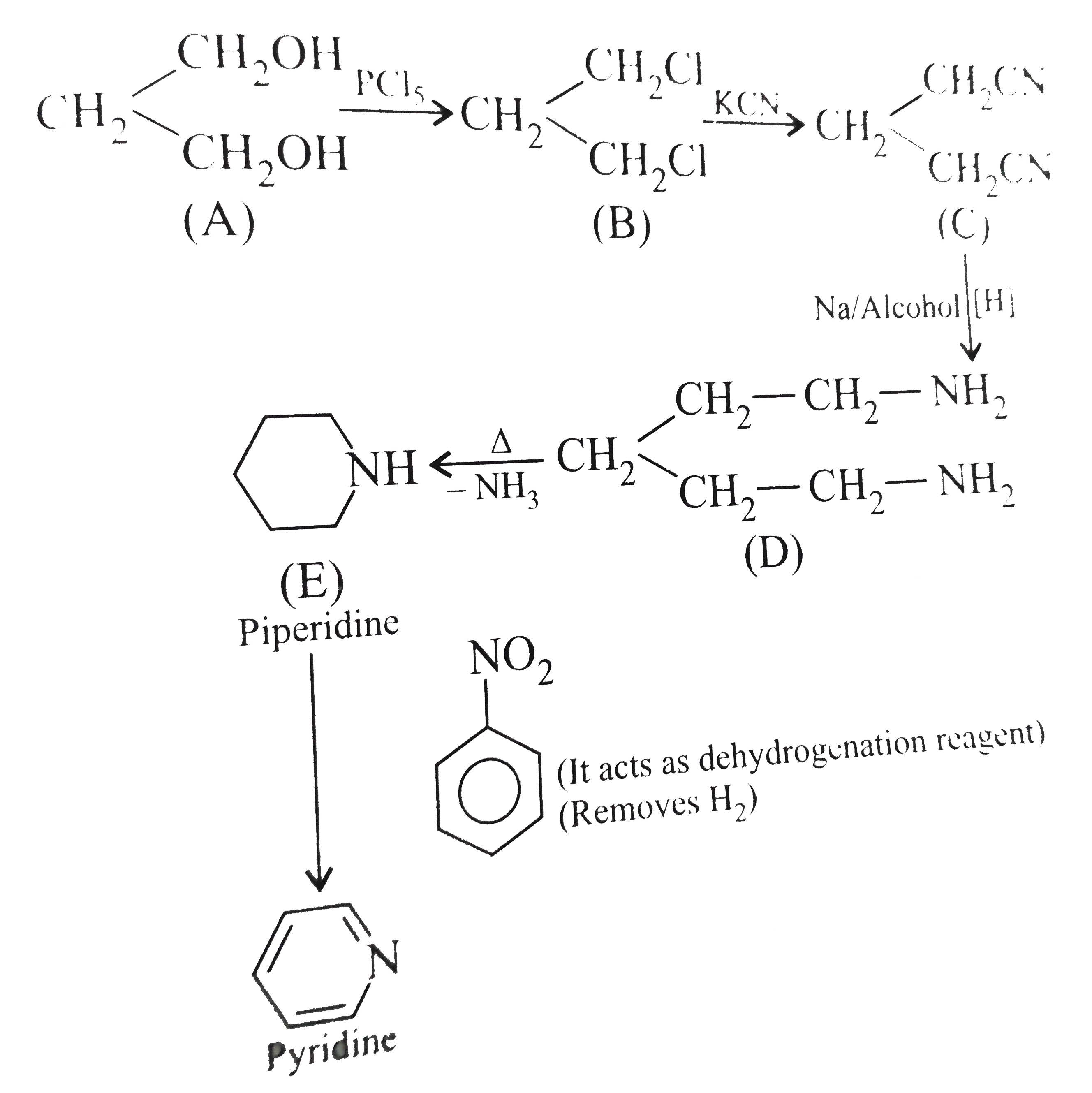An organic compound (A) composed of C,H, and O gives a characteristic colour with ceric ammonium nitrate. Treatement of (A) with PCl5 gives (B) which reacts with KCN to form (C). The reductionof (C) with warm Na/C2H5OH produces (D) which on heating gives (E) with the evolution of ammonia. Pyridine is obtained on treatment of (E) with nitrobenzene.
(A) rArr Colour with cerric amminium nitrate
rArr Alcoholic group
 .
.
Topper's Solved these Questions
- BOOK - CENGAGE CHEMISTRYCHAPTER - CARBOXYLIC ACIDS AND THEIR DERIVATIVESEXERCISE - Exercises (Linked Comprehension)34videos
CARBOXYLIC ACIDS AND THEIR DERIVATIVES
- BOOK - CENGAGE CHEMISTRYCHAPTER - CARBOXYLIC ACIDS AND THEIR DERIVATIVESEXERCISE - Exercises (Multiple Correct)35videos
CARBOXYLIC ACIDS AND THEIR DERIVATIVES
- BOOK - CENGAGE CHEMISTRYCHAPTER - CARBOXYLIC ACIDS AND THEIR DERIVATIVESEXERCISE - Solved Examples17videos
CARBOXYLIC ACIDS AND THEIR DERIVATIVES
- BOOK - CENGAGE CHEMISTRYCHAPTER - BIOMOLECULES, POLYMERS AND CHEMISTRY IN EVERYDAY LIFEEXERCISE - QUESTION BANK8videos
BIOMOLECULES, POLYMERS AND CHEMISTRY IN EVERYDAY LIFE
- BOOK - CENGAGE CHEMISTRYCHAPTER - CHEMICAL KINETICSEXERCISE - Archives Subjective23videos
CHEMICAL KINETICS
Similar Questions
An organic compound (A)(C5H8O3) on heating with soda lime gives (B) which reacts with HCN to give (C). The compound (C) reacts with thionyl chloride to produce (D) which on reaction with KCN gives a compound (E). Alkaline hydrolysis of (E) gives a salt (F) which on heating with soda lime produces n−butane. Careful oxidation of (A) with dichromate give acetic acid and malonic acid. Give the structures to (A) to (F) with proper reasoning.
View SolutionAn organic compound (A) C5H9Br which readily decolourises bromine water and KMnO4 solution gives (B), C5H11Br on treatment with Sn/HCI. The reaction of (A) with NaNH2 produces (C) with evolution of ammonia (C) neither reacts with sodium nor forms any metal acetylide but reacts with Lindlar catalyst to give (D) and on reaction with Na/liq.NH3 produces (E) .Both the compounds (D) and (E) are isomeric. Give structures of (A) to (E) with proper reasoning.
View Solution
Knowledge Check
- Question 1 - Select One
Acetamide on reduction with Na/C2H5OHgives:
AethylarnineBmethylamineCethaneDacetic acid - Question 2 - Select One
Acetaldoxime on reduction with Na/C2H5OH gives
A2-propanolBethylamineCacetaldehydeDethanol - Question 3 - Select One
An organic compound (A) with molecular formula C7H8O dissolves in NaOH and gives characteristic colour with FeCI3. On treatement with Br3, it gives a tribromo product C7H5Br3. The compound is:
Ap-HydroxybenzeneB2-Methoxy-2-phenyl propaneCm-CresolDp-Cresol
Two isomeric mononitro derivaters (B) and (C) are obtained by the nirtration of an organic compound (A),C7H8O. Treatment of (A0 with acetyl chloride products (D) which on reaction with CrO2Cl2 gives (E) whose oxidation with neutral KMnO4 followed by acidification gives (F). Compound (F) on heating gives pheonl. (A) on treatment with alkaline C6H5SO2Cl produces. (A) on treatment with alkaline C6H5SO2Cl produces (G) which on oxidiation with KMnO4 gives (H). Hydrolysis of (H) also gives (F). Give teh structures of (A) to (H).
View SolutionCompound A reacts with PCl5 to give B which on treatment with KCN followed by hydrolysis gave propionic acid. What is A and B respectively?
View SolutionThe compound A on treatment with Na gives B, and with PCl5 gives C. B and C react together to give diethyl ether. A, B and C are in the order
View SolutionThe compound A on treatment with Na gives B, and with PCl5 gives C. B and C react together to give diethyl ether. A, B and C are in the order:
View SolutionBoron reacts with oxygen at 700∘C to give (A). Compound (A) reacts with carbon and dry chloride to give (B) and carbon monoxide. (B) on reduction with LiAlH4 gives (C) along with LiCl and AlCl3.(C) on reaction with ammonia gives (D). Which on heating gives (E).(C) on reaction with NaH gives (F).
Compound (A) isView Solution

